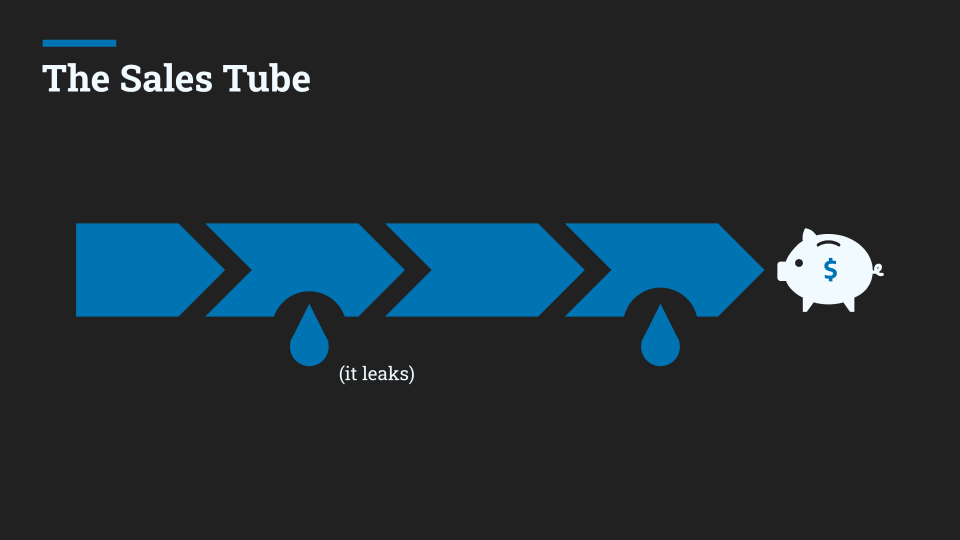Building Your Early Stage Content Strategy

People underestimate how much time and effort it takes to build out a content-based communications approach to the point that it reliably generates leads. And converting leads into sales takes time and effort as well. Not everyone who is curious about your thing will ultimately buy it.
But the idea of the sales funnel, where marketing sends ads out into the world and then the top of the big, wide funnel fills up with badly qualified leads that sales slog through one-by-one doesn't really work for early stage companies.

No one has heard of you yet, so your funnel is more like a tube that's full of holes. Especially if you're doing B2B stuff, and even more so for enterprise.
Your goal isn't to convince people who aren't that interested that they should buy your thing. Your goal is to find the people who desperately want your stuff but don't know you exist.
If you did your homework properly, these people should actually exist and your thing should do something useful. All you have to do is find where they hang out and go talk to them.
Simple, right?
Making Friends With People
The difficulty for early stage companies is that most of them haven't quite figured out who their customers are and what they want, what they're willing to pay, and a bunch of other stuff.
Part of the early process is discovering what people actually want, and how to talk to them about it. For your first 10 or so customers, you're basically making new friends. Your thing is a bit broken, so you need friends who will be honest with you about your flaws but love you anyway.

So spend the time to figure out the kind of friend you want to be to your customers.
That essence should come through in all of your communications to potential new friends: your website, the product, your emails, everything. You want to be consistent across channels and across time.
Consistency through time is the biggest challenge for a content strategy, for all companies, but especially early stage ones. You will need to churn out stuff every week for months, or years, and it all needs to fit into some sort of coherent overall story that stays the same. If the story changes, you have to throw out the stuff that doesn't fit any more and replace it with new stuff.
If all you have is a website and some sales decks, that's a lot easier than if you have 2 years of press, blogs, a full set of API documentation, HOWTO guides, whitepapers, and a fully automated email marketing system. Progress comes from building up each day, not trying to deadlift 150kgs on day 1 or running an ultra-marathon with no training. You'll just hurt yourself.
Build Your Marketing Information System
Start by building a Marketing Information System, which is fancy consultant language for “listening to customers”.
To start with, your CEO is head of sales. You might hire one more person as head of sales if you need to cover more ground. Don't hire more than that until you have enough inbound leads to keep them busy.
Spend heaps of time listening to customers respond to your pitch. They will tell you what they're looking for if you learn to listen.
The sales team is an excellent message testing system that gets fast results and you're already paying for it. Train them in interviewing customers and providing intel back to marketing and product teams.
It's amazing how often we work with clients where sales and marketing basically never talk to each other.
And you think DevOps is bad?
In the early stages, you're refining the message and the product so that it's both something your people want, and you know how to talk to them about it. Then you can scale it up to find more of your people. But where are they?
Ask them.
It should be part of your customer research to understand where they go to get information.
Who knows, maybe they pay close attention to local radio or cinema ads? Feel free to try out ideas, but maybe figure out what's most likely first and try that before you spend your whole comms budget on Tiktok or ads in Readers Digest.
Work Backwards From The Customer
How does this relate to content strategy? Too much of it is built inside out, based on what marketing wants to do or finds easy, instead of what customers find valuable.
At early stage, ask sales what customers say they don't understand or are struggling with. Then, solve those problems and explain those concepts. Do this before you do anything else.
The first stage of any content strategy is “sales support”. Until you have a few sales, you don't have a solution good enough to offer to more potential customers.
After a few sales, you should notice some patterns emerging. Beware over-optimising for what one customer does and assuming it applies to the entire market.
You should also notice some early traction on the “solve this problem” or “explain this thing” content you produce. Publish this stuff on a blog so people searching for a solution can find it.
Again, don't over-optimise for the one post that happens to get popular on Reddit or HackerNews or something. That's just luck.
You're trying to increase the frequency of getting lucky. There are no guarantees here.
But once you have what looks like a repeatable pattern, you can start laying down a basic conversion funnel. Awareness->Exploration->Consideration->Justification->Post-Purchase is one.
You're essentially building up the content you need for each stage of the funnel, but in reverse. Why? Because of how conversion funnels work, and because when you start it's more of a tube, remember?
At each stage of a conversion funnel/tube, people fall out. You want to get as many of the people through the tube and into sales as you can, so patch the holes closest to the money first.
You're basically adding layers to your conversion funnel as you need them, because you start by selling to people who already want to agree with you because they have such a big problem that you solve.
This also saves money and time wasted on building out content based on poor messaging or the wrong position. Fix them first.
It's also much easier to build the early stage content later because you have a bunch of customers who you can talk to and they'll tell you what you should have for those stages.
And I'm lazy, so I like doing it the easy way.

